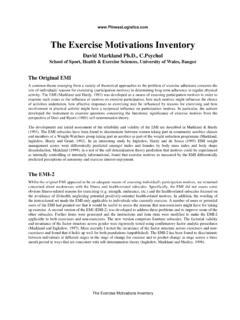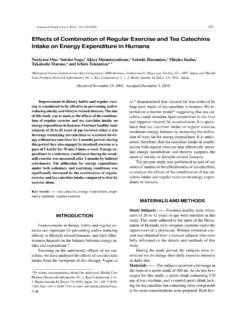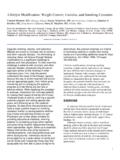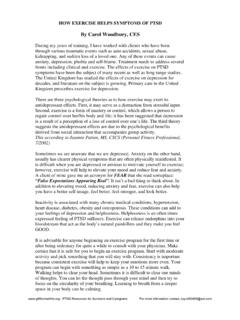Transcription of EXERCISE PHYSIOLOGY - About the Owasco Velo Club
1 Cycling Articles: PhysiologyTable of Contents1 EXERCISE PHYSIOLOGYThe Methods and Mechanisms Underlying Performanceby Stephen Seiler (sections 1 - 12)( ~ )Table of ContentsThe Endurance Performance Model31) The Heart5a) Basic physiologyi) More About how the heart adapts to training8ii) Maximal oxygen consumption - The VO2max9iii) The impact of body dimensions on endurance performance15iv) Gender differences in endurance performance & training17b) Myocardial Adaptations to Training27c) Aging and Cardiovascular Function31d) Understanding Heart Rate and Exercise322) Skeletal Musclesa) Basic Skeletal Muscle Physiology36b) Training Adaptations in Skeletal Muscle40c)
2 Aging Effects on Skeletal Muscle45d) Skeletal Muscle Fiber Type47i) The muscle biopsy49ii) Skeletal muscle fiber type - part 2503) Putting the Pieces Togethera) Lactate threshold?53b) Efficiency, economy and endurance performance58c) Brain - body link and adaptation to training634) Aging, EXERCISE and Short Term Power685) Principles of Training - Revisited846) The time course of training adaptations92 Cycling Articles: PhysiologyTable of Contents27) Understanding interval training988) Elite male distance runners 22 yrs later1119) Strength training and endurance performance11810) Muscle hypertrophy vs hyperplasia - a review12311) Ventilation and endurance performance13412) Aerodynamics and Cycling14813) Lactate Threshold15414) Weight training for cyclists17515) Racing Techniques19816) Cycling Climbing Tips204 Cycling Articles.
3 PhysiologyThe Endurance Performance Model3 THE ENDURANCE PERFORMANCE MODELW hether you run, row, ski or cycle, the goal is always the same; you areattempting to maximize your ACHIEVED PERFORMANCE VELOCITY. Allendurance sports demand some combination of three components: 1) Highoxygen transport capacity, 2) High fatigue resistance in working muscles, and3) High efficiency of transfer of physiological work to mechanical endurance athlete brings to the starting line some combination ofPerformance Power (1 and 2). The third variable, Efficiency of Power Transfer(3) links the engine to the specific movement task. These variables combine todetermine Potential Performance Velocity.
4 Finally, on a given race day,performance potential is influenced by psychological factors and the accuracyof pacing. The end product is ACHIEVED PERFORMANCE VELOCITY, apersonal best, a Masters record , we can list dozens of factors that impact enduranceperformance. To make things more complex (and interesting), these factorsare not independent, but influence each other. Finally, each particular sportdiscipline puts specific demands and constraints on the system through boththe specific resistance to movement that must be overcome, and the racedistance or all of this complexity, it is helpful to have a unifying model. So, I ampresenting one here for you that you can refer back to when you read otherarticles.
5 This model summarizes the currently accepted understanding of thephysiological limitations to endurance performance. In other words, it is thecurrent paradigm. Perhaps time will show that other factors should be included,or some of these deemphasized. For now, this model seems to fit the concept of the figure or this discussion is certainly not original. Itsummarizes the findings of nearly 100 years of physiological and performanceresearch. An excellent article on this subject based on research he hasdirected or assisted, and a fairly similar figure, were produced by EdwardCoyle PhD ( EXERCISE and Sport Science Reviews, , p25, 1995. Williamsand Wilkens, Publishers.)
6 Michael Joyner also wrote some excellentsynthesizing material on the issue of physiological limitations on performance(running). Journal of Applied PHYSIOLOGY 70:683-687, Articles: PhysiologyThe Endurance Performance Model4 Now, as complicated as the figure above may appear, it is still a the physical and anatomical components we could add: 1)genotype, 2) genetically determined responsiveness to training, 3) nutrition, 4)immunological resistance to stress, 5) testosterone level, 6) intensity of trainingstimulus, 7) frequency of training, 8) years of training load, etc. It is a fantasticpuzzle to explore, but remember, the solution is different for each Articles: Physiology1.
7 Heart Facts and Trivia51) HEART FACTS AND TRIVIAWhat's in a Name?The existence of the heart was well known to the Greeks, who gave it thename Kardia, still surviving in modern words such as cardiac and believed that the heart was the seat of the soul and the center of modified Kardia to Cor, the latter word still surviving in "cordialgreetings". The old Teutonic word herton was also derived from Cor and givesus heart via the medieval is it Located?Dumb question right? Well if you answered left chest, you're wrong! The heartis situated almost dead center in the middle of the chest nested between thetwo lungs. However, the apex or tip of the heart is shifted towards the left chestwall and hits against the ribs during contraction.
8 Consequently, the rhythm isbest detected on the left side, just below the Big is it?It is generally About the size of your fist. This is not really very big when youthink About the job it does. In some animals, such as horses, the heart size tobody size ratio is much greater. This helps explain why horses are such greatendurance athletes! The heart is also bigger in champion endurance athletes,due to genetics and training. (see subcategory-(b) below). The averageuntrained heart can pump About 15 to 20 liters of blood per minute at , elite athletes may have a maximal cardiac output of nearly 40 liters /min. This is a huge flow moving through a pump the size of your fist!
9 To getsome perspective on these output rates, go to your kitchen sink and turn onthe water full blast. Now find a milk jug or something that will give you ameasure of volume. I bet you find that your faucet does not flow as fast as theheart can a sense, the heart is really two linked pumps, the left heart and the sides pump the same amount of blood, but to different locations atdifferent pressures. The right side pump (right ventricle) pumps oxygen-depleted blood that has returned from the body to the lungs for is a short trip and requires little pressure development, so the rightventricle is rather thin walled, like a fireplace bellows. The left side (leftventricle) is the real workhorse, pumping oxygenated blood that has returnedCycling Articles: Physiology1.
10 Heart Facts and Trivia6from the lungs (the right and left side of the heart are thus connected) to theentire body. That means moving blood through an incredible maze of bloodvessels from the top of the head to the toes! Consequently it must developmore pressure each beat ( About 120mm Hg at rest). The left heart muscle isthicker as a result, just as your bicep would become thicker if you had to liftheavy weights with it all Does it Pump Blood?Classically, we have been taught that the heart squeezes blood through theaorta by decreasing the external circumference of the heart. This view issupported by the fact that during heart surgery (with the chest cracked open),the heart does pump in this manner.






